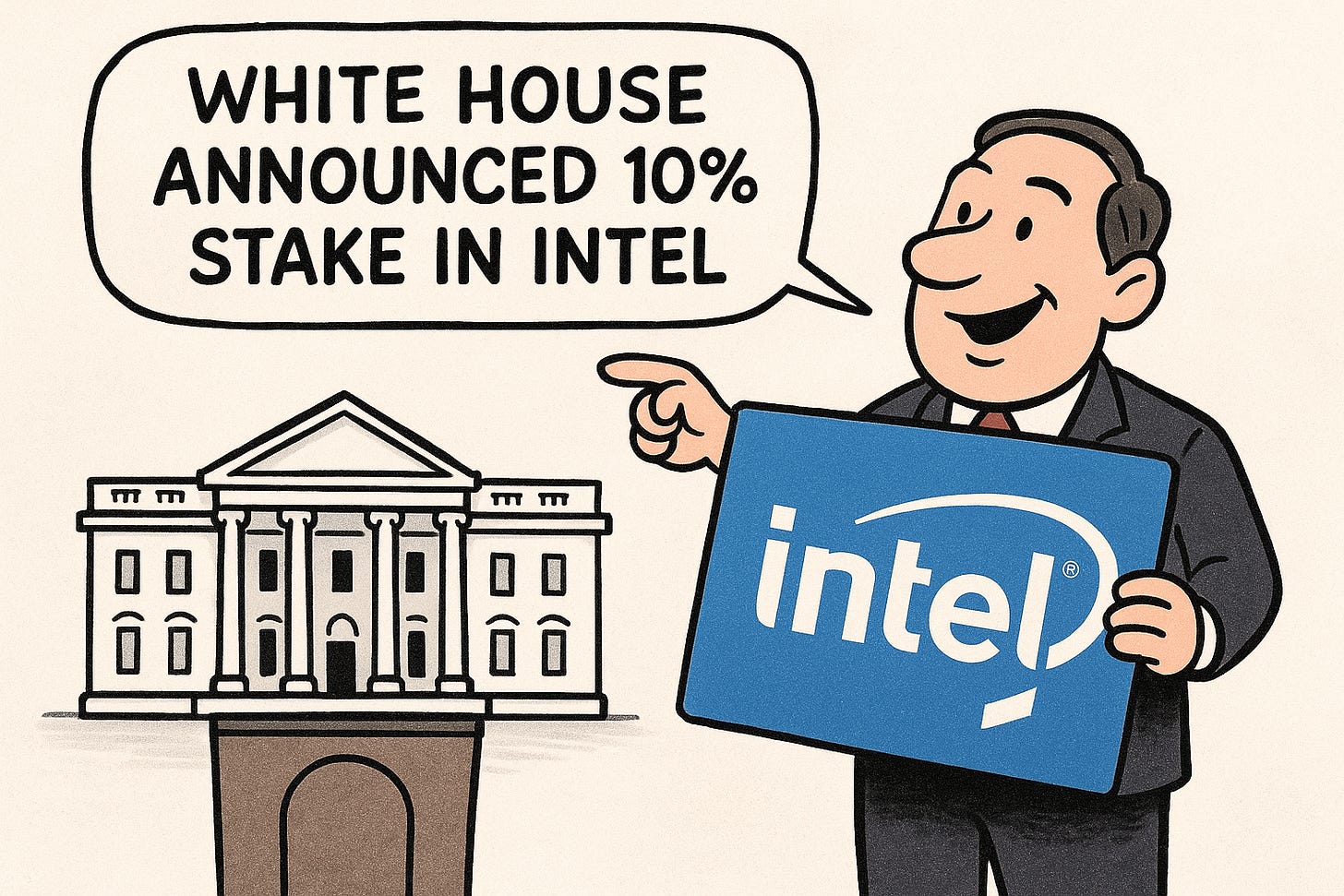White House announced 10% stake in Intel
Reason: not what you think
Dear Investor,
Zee here. Two weeks ago, the US government announced it had taken a 10% equity stake in Intel, converting nearly $9B of semiconductor subsidies into equity (at roughly $20.47/share). This makes them one of Intel’s largest shareholders, though the stake is passive, there are no government board seats or direct operational control.
This week, we have guest writer and a mentee of us, Aaron. Aaron is a keen analyst who explores the global economy through the lens of human behavior and philosophy. He wishes to help readers understand market movements and make better investment decisions.
Here goes…
What is a strategic industry and why is there an interest in Intel?
Strategic industries are those considered essential to a nation’s security, economic stability, and technological leadership. Semiconductors fall squarely into this category, underpinning everything from AI and defense systems to telecoms and critical infrastructure.
Intel remains one of the few US firms that conducts semiconductors research & development and manufacturing. The government’s stake aims to prevent Intel from divesting its fabrication (foundry) business, thus securing domestic manufacturing capacity amid rising competition from Nvidia, TSMC and Samsung.
U.S. Stake vs. China’s SOEs: Government support, not State control
Several senators have criticized this decision, questioned the effectiveness of Intel utilizing taxpayers’ money and even called the investment a step towards socialism. Is this warranted? Let’s take a look at how this differs in China.
Chinese SOEs typically feature majority state ownership, integrated strategic planning, and government-appointed executives, often deeply entrenched in national industrial policy. To name a few: China Mobile, Bank of China, Sinopec and SAIC Motor.
In contrast, the U.S. stake in Intel is limited, passive, and structured mainly to safeguard strategic capacity—not to direct operations or management. Intel remains a publicly traded, majority-private corporation.
The U.S. government has a long history of funding private companies when they are seen as strategically important, often through loans, guarantees, or equity stakes.
Here are a few notable examples:
Tesla (2010)
The U.S. Department of Energy granted Tesla a $465 million low-interest loan under the Advanced Technology Vehicles Manufacturing (ATVM) program.
Tesla repaid the loan in 2013, nine years early, and this funding is widely credited with helping it scale Model S production.
Banks (2008–2009)
Under the Troubled Asset Relief Program (TARP), the US government injected capital into major banks such as Citigroup, Bank of America, JPMorgan, etc. via preferred shares and warrants.
Most banks repaid with interest, resulting in an overall net profit for the US Treasury.
General Motors & Chrysler (2008–2009)
During the financial crisis, the U.S. invested ~$80 billion through TARP to rescue the auto industry.
GM temporarily became ~60% government-owned before shares were sold back to the market.
Should you follow Uncle Sam?
Intel may offer a speculative value opportunity for long-term, risk-tolerant investors, given its low P/S ratio (~2x vs AMD ~7.5x & Nvidia ~25x) and strategic positioning.
The company’s latest 2Q results reported a net loss of $2.9 billion, or 67 cents/share, compared with a $1.61 billion net loss, or 38 cents/share, y-o-y. Negative earnings mean Intel’s P/E ratio is not meaningful.
Under the leadership of their new CEO, Intel is taking steps to trim 15% of its workforce and reduce operating expenses by $17 billion in 2025. The company is also seeking big customers to anchor demand for its existing facilities and generate consistent revenue.
Intel remains a turnaround story, as success depends heavily on the execution of restructuring, business strategy and demand rebound. If it succeeds, today’s low valuation could offer some upside for patient investors.
Disclaimer: All information here is for educational purposes only. This is not financial advice. Please do your own research and speak with a licensed advisor before making any investment decisions. Past performance is not indicative of future returns.


